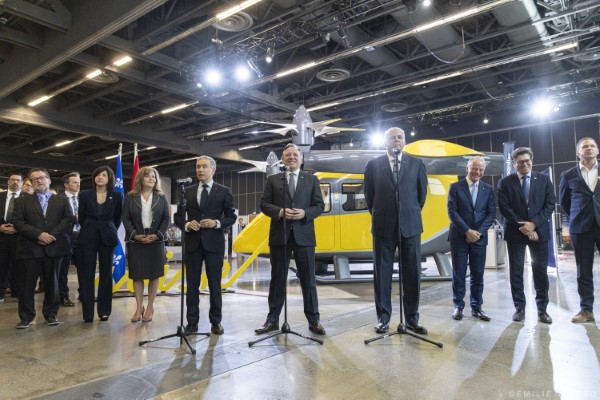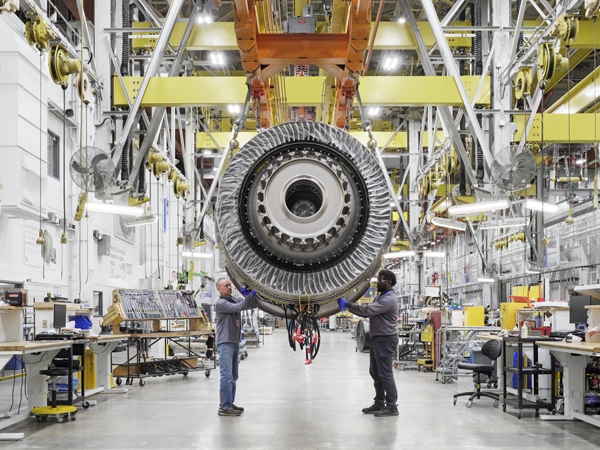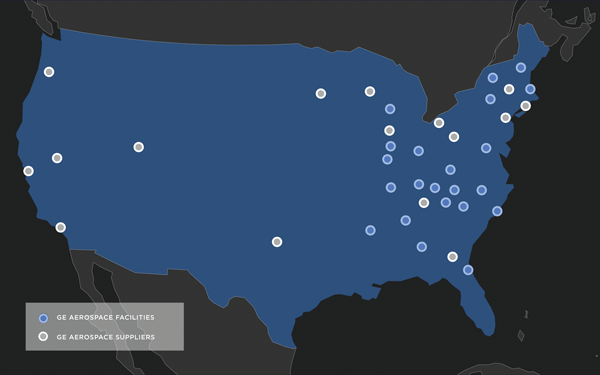Adecade ago, General Electric selected its engine parts plant in Auburn, Alabama, to lead a deeper plunge into the world of additive manufacturing. Today, 3D printers installed at the facility produce complex jet engine components from metal powders — a process more efficient than traditional manufacturing methods.
As testament to the Auburn plant’s increasing relevance, it’s been singled out for the largest in a series of hefty investments across 14 states by the newly named GE Aerospace. The $54 million Auburn infusion, announced in March, will allow the expansion of 3D printing for components such as high-pressure turbine airfoils, which the Auburn plant specializes in.
“The investments we announced today will enable Auburn to produce more cutting-edge components needed to meet growing demand in commercial and military aviation,” said site leader Antroine Townes in a statement.
In all, GE Aerospace is investing $650 million apportioned among 22 of its U.S. facilities ($450 million), 16 key domestic suppliers ($100 million) and international sites in North America, Europe and India ($100 million), in the process creating an expected 1,000 jobs.
Expansions of GE Aerospace facilities in the U.S. include investments in new machines, inspection equipment, building upgrades, new test cells and safety enhancements.
All newly announced facilities spending in the U.S. is going to aerospace plants east of the Mississippi River, including four in North Carolina totaling $46 million and three totaling $107 million in Dayton, Peebles and Evendale, Ohio — all in the neighborhood of Cincinnati. A $30 million investment in engine assembly and testing in Lynn, Massachusetts, is to support the production of U.S. and allied military helicopter and fighter jet engines.
Investments in suppliers are spread throughout the country among partners in New England, the Southeast, Midwest, Texas, California, Nevada and Oregon. The injection into the supplier base — more than double the previous year’s — is to help “build and maintain capacity and capabilities needed for sustained growth,” said a company statement. In an April earnings call, GE Aerospace CEO Larry Culp broke down the plan for addressing lingering supply chain constraints.
“We can track about 80% of our largest delivery challenges back to 15 supplier sites,” Culp said. “We’re deploying more than 550 engineers and supply chain resources — up 25% from last year — working with them to improve quality and delivery performance.”
Growth of the D.C. Metro Cluster
When The Aerospace Corporation announced in March that it was relocating its corporate headquarters from El Segundo, California, to Fairfax County in northern Virginia, leadership of the non-profit research and development lab sounded a refrain that’s become familiar among technology companies rushing to plant flags in and around the nation’s capital.
“By shifting our headquarters to the Washington, D.C., metro region, we will deepen our ties with key decision-makers and stakeholders and re-affirm our commitment to working side by side with our partners as they carry out our nation’s critical missions,” said Aerospace Chief Executive Steve Isakowitz.
As one of the D.C. metro’s top selling points for corporate investment, “proximity to the nation’s capital” isn’t what it used to be. It’s more.
“This,” says Anna Nissinen, senior vice president of the Fairfax County Economic Development Authority, “is where all the defense dollars are coming. We’re at the center of the world’s largest customer — the federal government — and we rank number one in the nation for government contracting dollars coming to our companies. And that number is growing.”
 Aerospace Corp. is working on NASA’s Artemis program to the moon.
Aerospace Corp. is working on NASA’s Artemis program to the moon.
Photo courtesy of NASA/Bill Ingall
Not long before the move by Aerospace — which despite the headquarters relocation to Chantilly, Virginia, is nonetheless investing $100 million in its El Segundo campus — aerospace and defense conglomerate RTX and Boeing both shifted their global headquarters to Arlington, another booming location in northern Virginia located just across the Potomac River from Washington. They joined global giants including General Dynamics, Northrop Grumman, Lockheed Martin, Rolls-Royce, BAE Systems and Airbus among the many aerospace and defense companies that make up the regional cluster.
Both Fairfax County and Arlington provide a muscular tech workforce and relatively lower costs than other major tech hubs, with Fairfax leaning toward the manufacturing and innovation side and Arlington a strategic location for government relations. A report from Avison Young on northern Virginia’s office market stated that aerospace and defense companies accounted for 32.9% of leasing volume during Q1 2024.
“We offer services and support for their growth journey,” Nissinen tells Site Selection. “We’re flexible, adaptable and resilient and I think that is our superpower. Things are changing fast. We don’t even know what’s going to be there in 10 years, but we’re adaptable to that. It’s as if every company in the aerospace and defense sector in particular are going to be in the space industry one way or the other.”
Québec Makes a Play for the Future
Aéro Montréal, the strategic think tank that helps drive the development of aerospace companies in Québec, announced in late May the formation of a designated aerospace innovation zone.
Espace Aéro, the organization said in a release, “will strengthen the attractiveness of the industry and the strategic international positioning of Québec’s aerospace sector. It will also propel Québec’s aerospace cluster to the next level of collaborative innovation and accelerate the transition to sustainable and intelligent air mobility, while attracting talent and companies from home and abroad.”
In a demonstration of the high-level support the initiative enjoys, the announcement was attended by François Legault, Québec’s premier; Pierre Fitzgibbon, the provincial minister of economy, innovation and energy; and François-Philippe Champagne, Canada’s influential minister of innovation, science and industry.
 Canadian dignitaries and aerospace leaders announce plans for Espace Aéro, May 21.
Canadian dignitaries and aerospace leaders announce plans for Espace Aéro, May 21.
Photo courtesy of Boeing
“After the Quantum Zone in Sherbrooke, the Digital Technologies Zone in Bromont and the Energy Transition Valley for batteries in Mauricie-Centre-du-Québec, I am very proud to announce the designation of a fourth innovation zone, in the aerospace field,” said Legault. “Concentrated in the Greater Montréal area, Espace Aéro brings together companies, universities and research centers to carry out training, cutting-edge research and applied testing.”
Boeing announced an immediate anchor investment of $75 million (CA$100 million) in an Aerospace Development Centre at Espace Aéro.
“Recognizing that Espace Aéro seeks to foster a culture of collaboration, with a mission to advance sustainable aerospace in Canada, Boeing is assessing additional projects to locate in Espace Aéro, aligned with the zone’s technology development priorities of decarbonization and autonomy,” said the Arlington-based company in a statement.
Boeing also announced additional investments in Québec-based enterprises, including $70 million (CA$95 million) in Wisk Aero’s autonomous electric vertical takeoff and landing aircraft and $25 million (CA$35 million) toward advanced landing gear research at Espace Aéro with Québec’s Héroux-Devtek. The company says the investments are part of Boeing’s Industrial and Technological Benefits commitment to Canada for its selection in December of Boeing’s P-8A Poseidon to fulfill its long-term multi-mission aircraft role.
“These investments serve as a testament to Canada’s aviation leadership and exemplify Boeing’s unwavering commitment to the country, where we have been driving innovation and fostering collaboration across the nation for over a century,” said Brendan Nelson, president of Boeing Global. “Québec’s aerospace capabilities are recognized worldwide, and we are excited to partner with the province on new initiatives that will generate cutting-edge technologies, drive economic growth and support decarbonization of aviation.”


